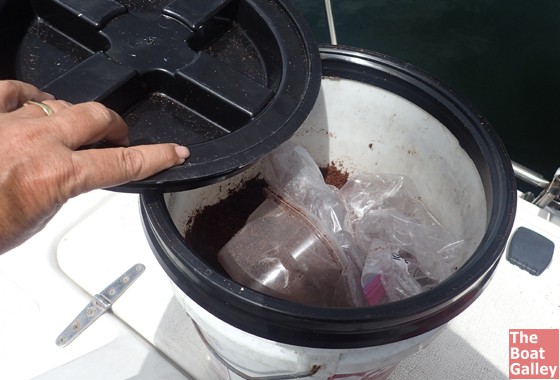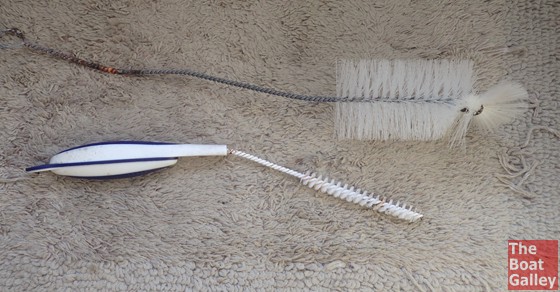On our vessel, Barefoot Gal, we changed from a traditional marine head to a Nature’s Head composting head. It’s been a learning process with the best info coming from other cruisers. Readers left some very helpful info on my “Learning to Love our Composting Toilet” post. So here is my contribution in the spirit of “paying it forward.”
Flattening the Learning Curve
We loved the composting toilet and would never go back to a traditional marine head. So this isn’t a post to the effect that we regretted it. We just wished there had been more complete information about how to use coconut coir as the compost medium. Saying to add water “until moist but not wet” just wasn’t specific enough for us. And what should you do if you did get flies. Figuring that others would probably like to know these things, too — here it is.
Coconut Coir
Coconut coir is a great compost medium. First off, it’s a readily renewable resource. Peat moss takes millions of years to form. Coconut also takes a lot less space to store and is far less likely to have bugs in it. But you do have to rehydrate it and crumble it up.
- After all sorts of experimenting on the right amount of water to rehydrate the coconut, we ended up using 1 cup of water per ad 2.75 pound brick. We used Beats Peat brand coconut, available on Amazon. It came in a package with four of the 2.75-pound bricks, for a total of 11 pounds. That is not a typo. Just ONE cup of water. (Note: Beats Peat doesn’t appear to be available any more. But this is a similar product.)
- We found that using very dry coconut and not initially filling the compost unit as full as the manufacturer recommends worked well for us. The drier coconut absorbs more moisture from the poop. This results in fewer problems with flies and gnats. And we can go a bit longer between compost changes. But since the coconut absorbs moisture and swells, we had to use less about 25% less material (1-1/2 gallons vs. 2 gallons recommended with peat) or the compost bin was quickly too full. And the handle became impossible to crank.
- One 2.75 pound brick did about 1-1/2 compost changes for us. With two of us aboard full time, we change the compost every three weeks. (Note: not a month like many manufacturers say). Thus an 11-pound package with 4 of the 2.75 pound bricks lasted us somewhere between three and four months.
- We use a large screwdriver to pry one of the 2.75-pound bricks off the “mother brick” and place it into a 2-gallon Ziploc (get on Amazon if your supermarket doesn’t carry them — the normal “large” Ziplocs are one gallon). We stab the top edge of the brick a couple times with the screwdriver. We then carefully pour 1 cup of water over that top edge. The holes we made with the screwdriver simply help the water penetrate. No problem if you don’t, just takes longer to soften.
- TIP: it helps to have a second person hold the bag as one pours the water in. At the very least, lean it against something securely. If it tips over before you’ve sealed the bag up, it’s messy.
- We sealed the Ziploc and place it in a sunny spot on deck. A couple times a day, we turned it over. And not opening the bag, try to bend the brick and get moisture to all areas.
- After the coconut brick and water has sat in sun and rehydrated for a couple of days, we get the 5-gallon bucket out (more on this next) and open the Ziploc bag. We break chunks off the coconut brick and crumble them into the bucket. Be careful to get rid of lumps. When it’s was all crumbled, we put the lid back on. We stored the bucket in the lazarette until we need to change the compost.
- We store the prepared coconut in a 5-gallon bucket with an air- and water-tight gamma seal lid. We prefer to prepare it well in advance of when we need it, so that we never get to a point where it needs to be changed but we’re not ready to. But we have to keep it in an airtight container so that it doesn’t pick up moisture from the very humid air here. We wanted it as dry as possible when we put it to use. After all, it’s supposed to be absorbing water from the poo!
- We store the “unprepared” coconut bricks in a sail locker where there is a slight chance of water leaks and drips. So that the coconut doesn’t get wet before we want it to, we keep the bricks in a heavy-duty 30-liter dry bag (see on Amazon).

Fly Control
Okay, this section isn’t fun and no one seems to discuss it. But it’s a fact of having a composting head. Sometime, you’re going to have a fly infestation. It happens. Not all the time. Or even every year. But sometime. Frankly, we find it less nasty than having to change a joker valve to deal with clogged hoses in a traditional marine head. First, some prevention tips.
- A Nature’s Head newsletter recommended using Gnatrol in the compost to eliminate problems with gnats (tiny little flies). It’s a biologic control (bacteria) specifically for fungus gnats and is normally packaged in 16-pound pails. The only place we could find it in small quantities was on Amazon. UPDATE: Amazon has stopped carrying the small packages and they are now available on eBay or at Organic BTi. We used 1 tablespoon when we changed the compost. We just mixed the dry powder into the fresh coconut. And we did not mix with water first. When we started doing this we never had flies or gnats again. (NOTE: We started by using 1 teaspoon and still had a few gnats; once we increased to a tablespoon, we didn’t.)
- When we had been unable to buy Gnatrol from Amazon, we had tried using a liquid formula — Bacillus Thuricide — that was supposed to be the same active ingredient. In just two months, we had an infestation of fungus gnats and read in several places that it is NOT the same thing as Gnatrol. That’s when I discovered that I could still buy Gnatrol in quantities from 1 oz. to 1 pound on Ebay and Organic BTI. (Read more and get links)
- Nature’s Head recommended that we sprinkle a bit of diatomaceous earth over the top of the compost each day. Don’t sir it in until the next time you’re cranking. This did not work for us so we stopped using it.
- For a while we used Rid-X Septic Tank Treatment Packs (1/2 pack per compost change). This supposedly helps the poo break down faster so flies are less attracted to it. It didn’t seem to make a difference, so we stopped doing this.
- If we saw flies in or around the compost bin, we used a shot of Flying Insect Spray into the compost bin. Since using the larger dose of Gnatrol, we did not have to use fly spray.
Fly Infestation
Fly infestations need to be dealt with as soon as you think you might even remotely have a problem. We had one. But it took us two tries to eliminate it as we just didn’t realize what drastic action was needed.
- There will be fly larvae on the inside of the compost bin. On the Nature’s Head, there will be eggs/larvae in every nook and cranny of the top. Dump the compost as normal into a trash bag. Then get every bit of crud out that you can with a stick or scraper. Remove the fan if your unit has one. Then use a tank sprayer with water to get out all the larvae. We found that brushes with long wire handles that we could bend made it easier to scrub everywhere. Be sure to get under edges everywhere. If any are left, there will be a second infestation and you’ll have to do it again (how do I know this?).

- We found our brushes in a hardware store in the Bahamas as we were preparing to do the second clean out. It’s better to get them before you need them, as every day that you spend getting supplies is a day that the flies multiply and lay more eggs. Prices are also cheaper when you’re not desperate. Coarse bristles work much better than soft. These are the style and sizes that worked well for us.
- After cleaning it all out, we poured and sprayed white vinegar everywhere in the unit, dumped it out, then let it dry. Then we refilled with coconut and began using it again. For the next week or so, we used fly spray daily to hopefully kill any before they laid more eggs.
- I’ve heard of people using pressure washers, boiling water, bleach and/or dunking the unit in the ocean to thoroughly clean it. It all depends on where you are and what’s available — and legal.
- One note on cleaning the unit out: If your unit has a fan, the wires on it are tiny, easy to break and generally can’t be repaired. Be careful with it as you remove the fan. We now carry a couple of spare fans with wiring.
Hope this helps others making the transition to a composting head.
Related Posts
Flatten the learning curve with practical how-to info that gives you the confidence to step into life aboard.
Start Learning Today

Carolyn Shearlock has lived aboard full-time for 17 years, splitting her time between a Tayana 37 monohull and a Gemini 105 catamaran. She’s cruised over 14,000 miles, from Pacific Mexico and Central America to Florida and the Bahamas, gaining firsthand experience with the joys and challenges of life on the water.
Through The Boat Galley, Carolyn has helped thousands of people explore, prepare for, and enjoy life afloat. She shares her expertise as an instructor at Cruisers University, in leading boating publications, and through her bestselling book, The Boat Galley Cookbook. She is passionate about helping others embark on their liveaboard journey—making life on the water simpler, safer, and more enjoyable.










Carolyn Shearlock says
From what I understand, they generally infest after it’s opened and hydrated and in use (we have never seen any immediately or when the prepared coconut is being stored but rather several weeks into using it — but I assume anything is possible). We don’t have a microwave on board, so I can’t try it.
Carolyn Shearlock says
Update via email:
Recall your recommendation for gnats was a Bacillus thuringiensis (Bt) formulation.
Home Depot carries for $8 “Thuricide” Bt caterpillar control, concentrated liquid.
Reading the label… I believe this won’t work if you have put diatomaceous earth in your media; says ‘do not combine with alkaline material’ and diatom earth would qualify.
That said, I should think this would be instead of DI anyway.
Carolyn Shearlock says
The website says about a week for 2 people, but most that I know actually get closer to two weeks.
Carolyn Shearlock says
I do know some people have built their own and they are cheaper. You can find plans online.
Carolyn Shearlock says
Apparently Amazon is no longer selling the small containers of Gnatrol. The active ingredient in Gnatrol is bacillus thuringiensis. Another reader reports that Home Depot sells a liquid version called “Thuricide” — you can also buy it on Amazon: https://amzn.to/2IA5kFl
clint stoever says
We’re using our old deck pump out fittings as our air exit for our heads on our sailing catamaran. We simply added a PVC adaptor and a 30 degree PVC piece. We can then turn them as needed. We typically turn our windward side PVC piece aft as to allow air flow. We turn our leeward side PVC piece out and this seems to allow foul air to flow away from the boat. When at anchor, we turn them both out and this help keep the smell away from the cockpit. Hope this helps.
Johnnie Allred says
Go to Lowes or Home depot and ask for Bt.
Kelly Couch says
Oh man… that’s not an option. We live here full time and have kids with chemical sensativites….. 🙁
Carolyn Shearlock says
I live here full time too. Are you sure they are sensitive to Home Defense? They say it’s okay for kids and pets and everything as soon as the spray dries. It doesn’t bother my husband and he definitely has reactions to some pesticides. It’s much less smelly than Raid or anything, which are the only other options if you’ve tried the DE and thuricide (and Raid, etc. doesn’t work nearly as well).
bob says
We had this problem e-mailed C-Head and they sent us a mixing spoon with a hole cut into it. It was frustrating and off-putting so I cleaned up the pee section and took out my electric heat gun and molded the aft dam back an inch at the top and tried to keep the curve the same as the bottom of the shute. I hope your effort looks better than mine. It is possible to overheat the plastic so be careful by constantly monitoring the heat going to the plastic. Too hot and it bends too quickly, too cold and you can stress hard spots. This process made the pee reservoir just larger enough to work. It also raised the height of the dam at the back and this helps as well. We learned this by using a sepperat unit at home and it came with a fitting to raise the height of the dam and that worked well. My wife gives this her thumbs-up of approval. She also hopes this helps your friend.
Carolyn Shearlock says
Dave says he fills ours about an inch below the mixing bar, I say a couple inches. I’d definitely take some of the coconut out based on our early experiences — as it absorbs moisture from the poo, it will expand and make it impossible to turn. And if you add too much water, it won’t absorb the moisture from the poo AND the moisture will seep out through the holes for the mixing bar. Definitely use less coconut!!
P.S. Adding that much more water is not the solution. In my experience, the folks at NH use peat moss instead of coconut and their answers about what we needed to do to “fix” our problems just made things worse. It was only when we talked to other NH users that we got ideas that worked: namely, drier coconut and not filling it so full.
You can buy non-compacted coconut on Amazon and use it with ZERO water very successfully — we used it for nearly a year. So water is not needed. If you get it, make sure it does NOT have fertilizer added.
James Shell says
If someone would try the equine stall pellets from Tractor Supply, Co., it might prove very useful. I use it in the simpler sawdust toilet with excellent results, in my experience better than coir or peat moss.. The sawdust that is produced from the hydration of the pellets may work as well, or better, than coir or peat moss. It certainly is cleaner to handle…but that is a low priority characteristic. We must have odor control and lasting ability in the tank.
(https://www.tractorsupply.com/tsc/product/tractor-supply-pine-pellet-stall-bedding-40-lb?solr=1&cm_sp=SearchPreview-_-DidYouMean-_-Product&cm_vc=-10005)
Garet says
James, do you pre-hydrated the pellets, or put the dry, compressed pellets directly in the receiving bin?
Carolyn Shearlock says
Yes, no problem. Some people who just use their boats on weekends only change it once a year. Just crank the handle every day to keep things mixed. It will actually decompose better if left longer and not used as much.
Carolyn Shearlock says
We prepare one brick at a time, and it’s more than enough for a change. We use 2 gallons of prepared coir per change.
Christin Miller says
I tried the horse sawdust pellets for my Airhead. With a little axra moonstone from the poo it became heavy and wet would not dry out and became impossible to turn.
I do use the pellets in my cat litter box.
Fiona says
We started microwaving our coconut coir in small batches and storing them in large baggies ready to hydrate when we need them. We haven’t had any gnats since (knocking on wood) but this is still a fairly new process we started so the jury is still out but it does seem to be helping.
Carolyn Shearlock says
I’ve never heard of anyone doing that, but don’t see where it would be a problem. And if it works for you, great!
Carolyn Shearlock says
No. Are you full-time aboard?
Chuck B says
No, only weekends right now. Plus, this is in California where the air is relatively dry. And the fan is running 24/7. I moistened the coconut coir according to Air Head’s instructions before reading about your coir-to-water mix ratio, so it was perhaps a bit more water than necessary, but not by a whole lot. Certainly the coir did not feel damp at all. But now the tank is filled with gray fur. :-/ Just installed the Air Head a few weeks ago so I’m new to this.
P.S. Apologies for the slow response, I’m not getting notifications of replies.
Carolyn Shearlock says
I’d almost wonder if it wasn’t something in the coir — mold lying dormant. When you mix up your next batch, try keeping it drier and maybe add a tablespoon or two of bleach to the water to kill anything that might be in the coir.
Sal says
To get rid of gnats in your house, make a gnat trap. I used to work in a genetics lab and this is a fast solution as long as you just need to remove them and you’ve sealed all incoming sources!
Take a bottle or jar and a piece of paper (paper for a printer works well). Curl the paper into a funnel that will fit into the top of your jar snugly. One open end (the end going into the jar) should be just barely big enough for a gnat to fit through. The other open end should be fairly large. Tape the funnel to maintain the shape and fit it into the top of the jar. If there are any gaps at all, tape the funnel and the jar lip together to seal those. Before you do this, however, add a bit of banana as bait to the jar.
Within just a day or two, your jar will have trapped your gnats. They can get in, but not out! You can either empty it outdoors or place the whole thing in your freezer first to kill the gnats.
Marla says
Thank you for all this info. I am on my 2nd month using an Airhead and just now experienced gnats in the solid tank. No problem the first month. Emptied and replaced coir after 4 weeks. This time no such luck. Will try the drier coir suggestion. Just wanted to double check that after you pour the cup of water over the brick and put it out in the sun you have it out for a few *days* before you break apart or hours. Thank you!